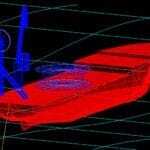STA CHAIN, Buried Anchor Chain Program
STA chain is a computer program for the analysis of anchor chain (or wire) cutting through soil. The program was originally developed for work with the US Navy and plate anchors in 1988. The program does not consider how the end of the chain may have been embedded. However, the analysis considers a lateral load applied to a chain and calculates its equilibrium cut profile through the sea bed.

STA CHAIN permits the user to specify up to two different soil layers, each of which may have varying strength properties. The layers must be cohesive soils. Primary results from the program provide the tension vector the chain (or cable) applies at the buried padeye, given the load and angle specified by the user at the top end.
View STA CHAIN User Manual.
Theory
The basis of the method is to assume a planar chain configuration, with chain ‘tension forces and chain self weight, balanced at each elemental location by soil forces. These soil forces are considered both normal to, and tangential to each chain elemental section. The figure below shows the forces acting on a finite element of the chain.

Input Data

Principal Results

- Chain length from padeye to sea bed is the length measured along the chain from the padeye to the point where the chain leaves the sea bed. The equilibrium and geometry of chain elements may be calculated beyond the padeye, but this does not affect padeye forces.
- Original chain length is the length measured vertically upwards from the padeye to the sea bed and then horizontally along the sea bed to the point where the chain actually exits.
- Length “lost” in cutting through the soil is the difference between the above two terms.
- Chain tension at padeye depth is the tension in the chain at the depth of the padeye specified by the user. Chain tensions below this will be calculated if the initial element length is large enough. If the initial element length is too small (the chain profile will show if this is the case) the program will print a warning CHAIN TOO SHORT; INC.EL.LENGTH!.
- Chain angle to horizontal at padeye is angle of the chain at the depth of the padeye specified by the user. A warning is printed if the chain is too short.
- Horizontal force at the padeye is the horizontal component of the tension in the chain calculated at the depth of the padeye specified by the user. A warning is printed if the chain is too short.
- Vertical force at the padeye is the vertical component of the tension in the chain calculated at the depth of the padeye specified by the user. A warning is printed if the chain is too short.
- Depth to first point where theta = 90 is the depth to the point where the chain angle becomes vertical. If the upper element size is small and the soil is soft the chain modeled may not be long enough to reach a vertical attitude. If this is the case a warning is printed, CHAIN DOES NOT BECOME VERTICAL! This may be what the user wants and does not imply any error condition.
- Tension in chain at theta = 90 is the tension calculated at the point where the chain angle becomes vertical. (See 4.8, above).
- Maximum depth of soil in analysis is the depth of the last chain element. This depth is increased or decreased by adjusting the upper element length. Generally simply click on the “Solve Upper Element Length” button.
- Chain tension at maximum depth is the tension calculated in the last chain element modeled. Note that this may be anywhere in the range from zero to the applied top tension, depending on soil and chain parameters selected by the user.
Additional Charts


STA CHAIN is widely used in the offshore and marine industries for calculating mooring chain and wire vertical and horizontal load components on padeyes on suction pile anchors.


